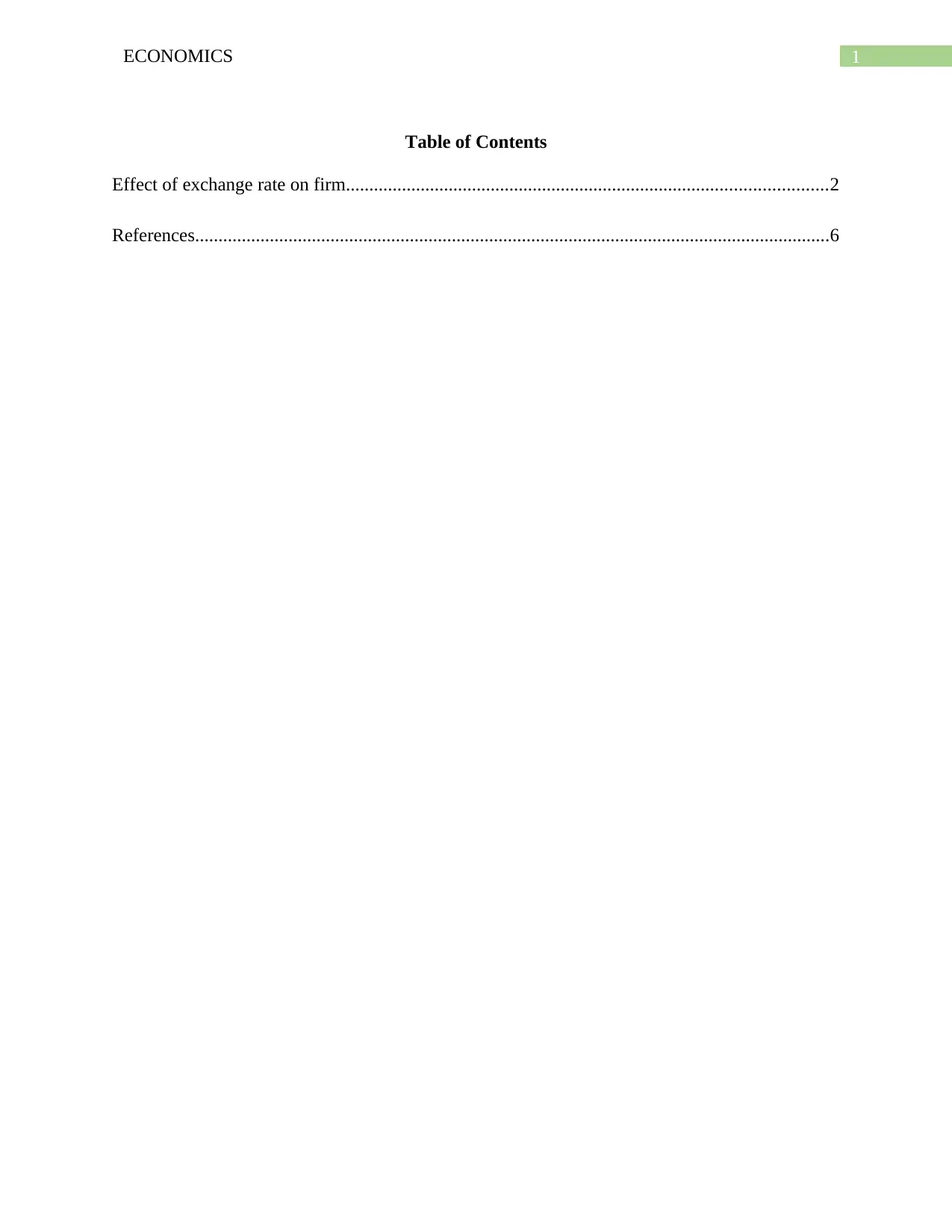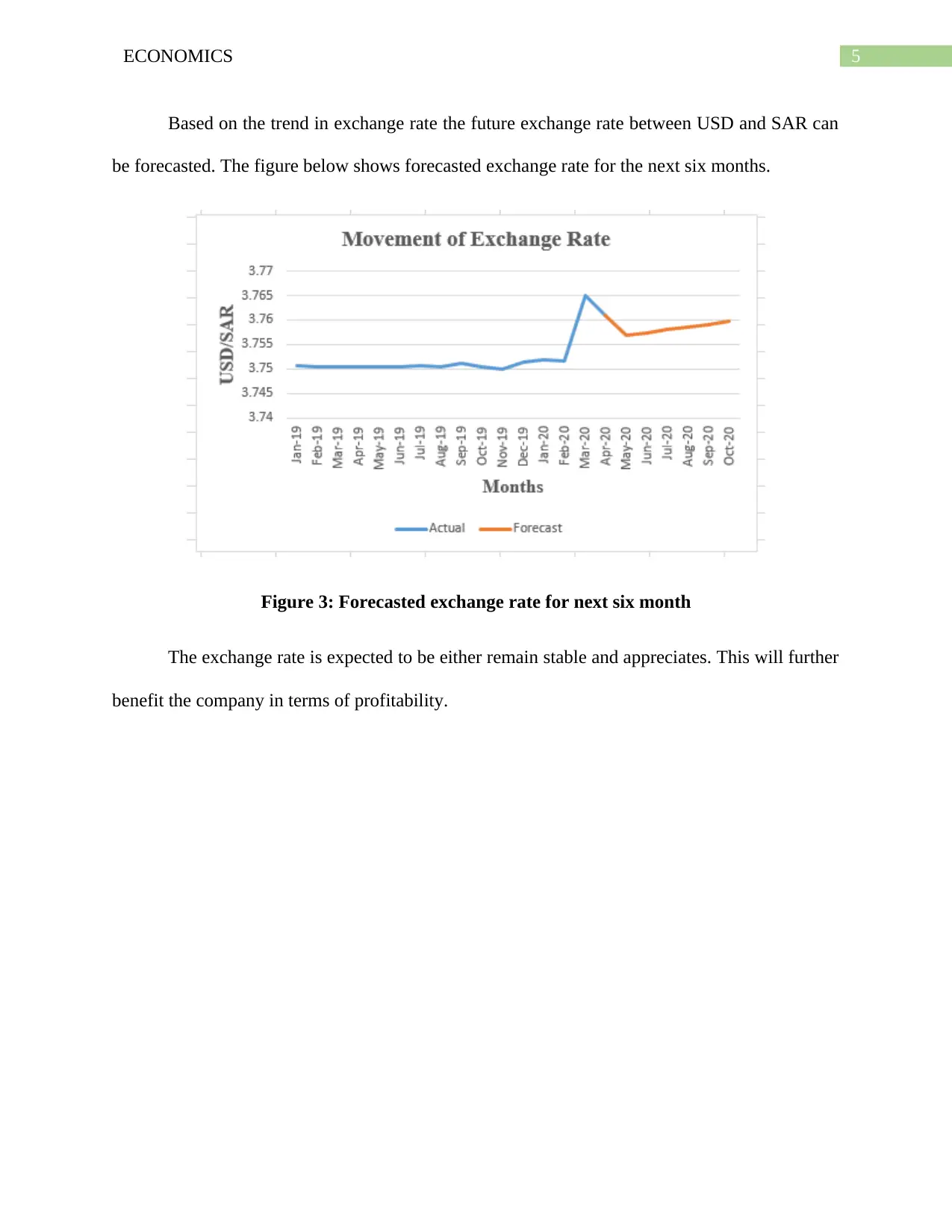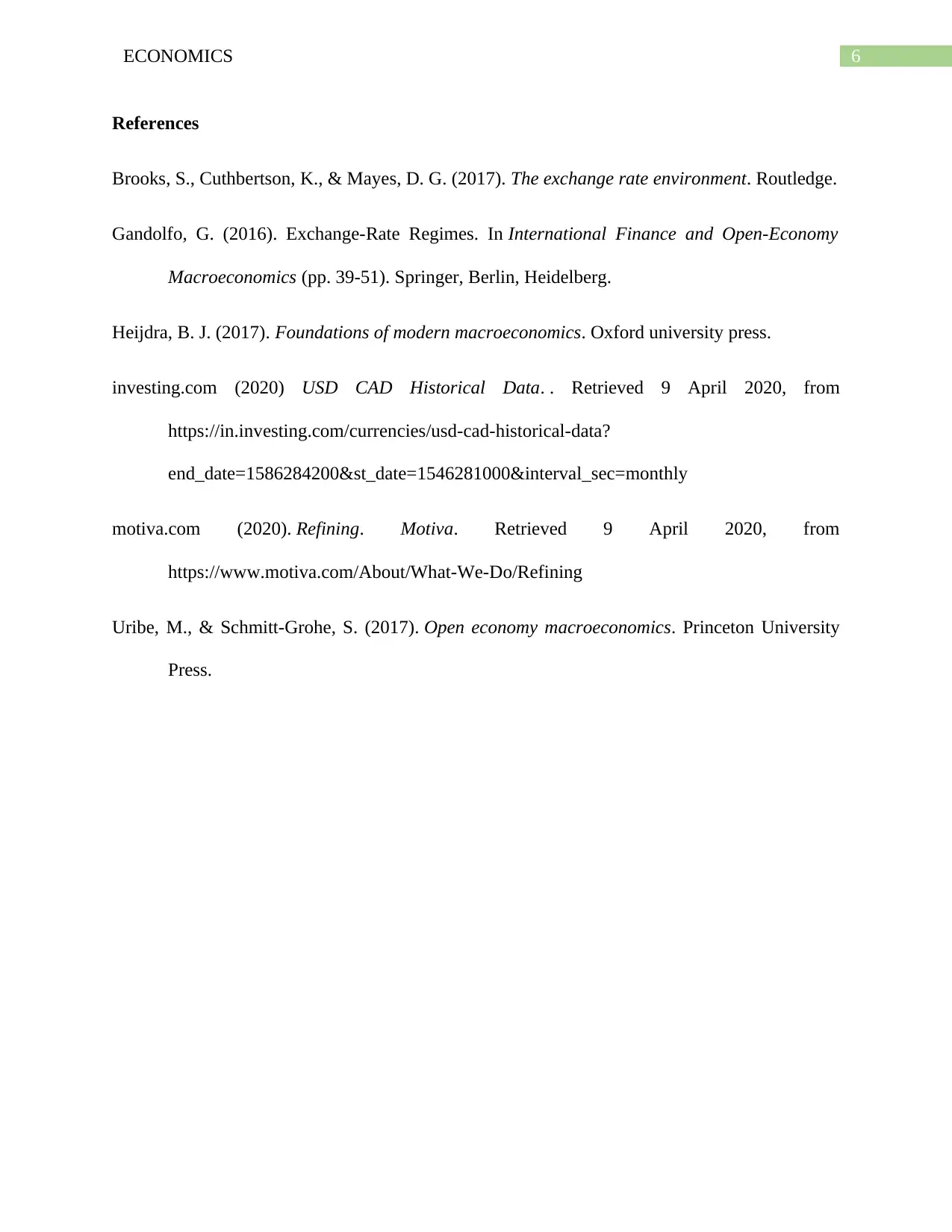Economics Report: Analyzing Exchange Rate Effects on a Petroleum Firm
VerifiedAdded on 2022/09/13
|7
|998
|32
Report
AI Summary
This report examines the impact of exchange rate fluctuations on the petroleum industry, specifically focusing on the Port Arthur Refinery. The analysis explores how changes in the USD/SAR exchange rate affect the company's cost of production, profitability, and supply of refinery products. The report illustrates how currency appreciation can lead to reduced import costs, increased supply, and potential for expanded sales. Furthermore, the report provides forecasted exchange rate trends and discusses strategies for profiting from future shifts in the exchange rate. The study employs supply and demand curves to demonstrate the effects of currency fluctuations on industry price and quantity, supported by relevant data and references.

Running head: ECONOMICS
Economics
Name of the Student
Name of the University
Course ID
Economics
Name of the Student
Name of the University
Course ID
Paraphrase This Document
Need a fresh take? Get an instant paraphrase of this document with our AI Paraphraser

1ECONOMICS
Table of Contents
Effect of exchange rate on firm.......................................................................................................2
References........................................................................................................................................6
Table of Contents
Effect of exchange rate on firm.......................................................................................................2
References........................................................................................................................................6

2ECONOMICS
Effect of exchange rate on firm
Firms having exchange relation with rest of the nation in world are exposed to risk of
change in currency exchange rate. The same appreciation or depreciation of currency has a
different effect on companies that import raw material from other nations compared to
companies that export goods to global market. Depreciation of a currency indicates a fall in value
of home currency relative to foreign currency. An appreciation in contrast implies increase in
value of domestic currency relative to foreign currency. In case the firm is selling goods to the
global market, depreciation of currency results in an increase in demand for its product by
making it cheaper in the world market (Heijdra, 2017). This enhances sales and profitability.
However, if the firm depends on imported raw material then depreciation increases cost of
production by raising cost of imported inputs. Opposite occurs when currency appreciates.
Appreciation of currency reduces export demand by making the good expensive in the world
market. This reduces sales and profitability. However, if the firm is dependent on imported
inputs then appreciation of currency reduces production cost and help the company to expand its
production (Gandolfo, 2016).
Oil refining companies constitute an important part of petroleum industry. Port Arthur
Refinery. The approximate production volume of the company is 607, 000 barrels/day. In case of
oil refining companies, the cost of crude oil is the most vital component of total production cost.
The oil refining companies purchase crude oil from the producer and then convert it into
different petroleum products. Port Arthur Refinery engages in processing a considerably wide
range of crude oil inputs such as tight oil, sour, heavy and acid crudes. Majority of the crude oil
that the company processes come from Saudi Arabia (motiva.com, 2020). The company though
has diversified its source of imported crude to other nations having sufficient reserve of crude oil
Effect of exchange rate on firm
Firms having exchange relation with rest of the nation in world are exposed to risk of
change in currency exchange rate. The same appreciation or depreciation of currency has a
different effect on companies that import raw material from other nations compared to
companies that export goods to global market. Depreciation of a currency indicates a fall in value
of home currency relative to foreign currency. An appreciation in contrast implies increase in
value of domestic currency relative to foreign currency. In case the firm is selling goods to the
global market, depreciation of currency results in an increase in demand for its product by
making it cheaper in the world market (Heijdra, 2017). This enhances sales and profitability.
However, if the firm depends on imported raw material then depreciation increases cost of
production by raising cost of imported inputs. Opposite occurs when currency appreciates.
Appreciation of currency reduces export demand by making the good expensive in the world
market. This reduces sales and profitability. However, if the firm is dependent on imported
inputs then appreciation of currency reduces production cost and help the company to expand its
production (Gandolfo, 2016).
Oil refining companies constitute an important part of petroleum industry. Port Arthur
Refinery. The approximate production volume of the company is 607, 000 barrels/day. In case of
oil refining companies, the cost of crude oil is the most vital component of total production cost.
The oil refining companies purchase crude oil from the producer and then convert it into
different petroleum products. Port Arthur Refinery engages in processing a considerably wide
range of crude oil inputs such as tight oil, sour, heavy and acid crudes. Majority of the crude oil
that the company processes come from Saudi Arabia (motiva.com, 2020). The company though
has diversified its source of imported crude to other nations having sufficient reserve of crude oil
⊘ This is a preview!⊘
Do you want full access?
Subscribe today to unlock all pages.

Trusted by 1+ million students worldwide

3ECONOMICS
it still depends on Saudi Arabia to a great extent. The refining company supplies its refinery
products such as aviation fuels, gasoline, high quality base oil and diesel to the customers in
United States. Therefore, fluctuation in exchange rates affect the company in terms of input cost.
Since, majority of crude oil is imported from Saudi Arabia change in currency exchange rate
between United States and Saudi Arabia affects the company. The figure below shows trend
exchange rate between USD and SAR for the last 16 months.
Figure 1: Trend in USD/SAR exchange rate
(Source: investing.com, 2020)
From the trend exchange rate, it has been observed that on May 2018, exchange rate
between USD and SAR was 3.7504. This implies 1 USD is traded for 3.7501 SAR. The
exchange rate though remains more or less stable however there is marginal increase in the
exchange rate with last recorded exchange rate between USD and SAR being 3.7610. That
means, currently 1 USD is traded for 3.7610. This means there is a depreciation of SAR while
appreciation of USD. Since the company depends on imported crude oil from Saudi Arabia,
it still depends on Saudi Arabia to a great extent. The refining company supplies its refinery
products such as aviation fuels, gasoline, high quality base oil and diesel to the customers in
United States. Therefore, fluctuation in exchange rates affect the company in terms of input cost.
Since, majority of crude oil is imported from Saudi Arabia change in currency exchange rate
between United States and Saudi Arabia affects the company. The figure below shows trend
exchange rate between USD and SAR for the last 16 months.
Figure 1: Trend in USD/SAR exchange rate
(Source: investing.com, 2020)
From the trend exchange rate, it has been observed that on May 2018, exchange rate
between USD and SAR was 3.7504. This implies 1 USD is traded for 3.7501 SAR. The
exchange rate though remains more or less stable however there is marginal increase in the
exchange rate with last recorded exchange rate between USD and SAR being 3.7610. That
means, currently 1 USD is traded for 3.7610. This means there is a depreciation of SAR while
appreciation of USD. Since the company depends on imported crude oil from Saudi Arabia,
Paraphrase This Document
Need a fresh take? Get an instant paraphrase of this document with our AI Paraphraser

4ECONOMICS
appreciation of USD against SAR is good for the company. As USD depreciates it costs less to
the company to purchase crude oil from Saudi Arabia. With a decline in imported cost of crude
oil, cost of production falls (Gandolfo, 2016). This helps the company to produce more and
increase supply of refinery product in US. The impact of exchange rate appreciation on the firm
is shown in the figure below.
Figure 2: Impact of currency appreciation
DD and SS curve in the above figure shows the respective demand and supply of the
refinery. Now, as USD appreciates, import cost falls causing an increase in supply of refinery
products. The supply curve shifts outward causing an increase in quantity at equilibrium while a
decrease in price.
Using the shift in the exchange rate the company can expand sales and profit. The
company though mainly sales refinery products to meet the demand of US customers, given the
excess production the company can now sell the refineries to the global market (Uribe &
Schmitt-Grohe, 2017). As the market diversifies, the company can earn more profit.
appreciation of USD against SAR is good for the company. As USD depreciates it costs less to
the company to purchase crude oil from Saudi Arabia. With a decline in imported cost of crude
oil, cost of production falls (Gandolfo, 2016). This helps the company to produce more and
increase supply of refinery product in US. The impact of exchange rate appreciation on the firm
is shown in the figure below.
Figure 2: Impact of currency appreciation
DD and SS curve in the above figure shows the respective demand and supply of the
refinery. Now, as USD appreciates, import cost falls causing an increase in supply of refinery
products. The supply curve shifts outward causing an increase in quantity at equilibrium while a
decrease in price.
Using the shift in the exchange rate the company can expand sales and profit. The
company though mainly sales refinery products to meet the demand of US customers, given the
excess production the company can now sell the refineries to the global market (Uribe &
Schmitt-Grohe, 2017). As the market diversifies, the company can earn more profit.

5ECONOMICS
Based on the trend in exchange rate the future exchange rate between USD and SAR can
be forecasted. The figure below shows forecasted exchange rate for the next six months.
Figure 3: Forecasted exchange rate for next six month
The exchange rate is expected to be either remain stable and appreciates. This will further
benefit the company in terms of profitability.
Based on the trend in exchange rate the future exchange rate between USD and SAR can
be forecasted. The figure below shows forecasted exchange rate for the next six months.
Figure 3: Forecasted exchange rate for next six month
The exchange rate is expected to be either remain stable and appreciates. This will further
benefit the company in terms of profitability.
⊘ This is a preview!⊘
Do you want full access?
Subscribe today to unlock all pages.

Trusted by 1+ million students worldwide

6ECONOMICS
References
Brooks, S., Cuthbertson, K., & Mayes, D. G. (2017). The exchange rate environment. Routledge.
Gandolfo, G. (2016). Exchange-Rate Regimes. In International Finance and Open-Economy
Macroeconomics (pp. 39-51). Springer, Berlin, Heidelberg.
Heijdra, B. J. (2017). Foundations of modern macroeconomics. Oxford university press.
investing.com (2020) USD CAD Historical Data. . Retrieved 9 April 2020, from
https://in.investing.com/currencies/usd-cad-historical-data?
end_date=1586284200&st_date=1546281000&interval_sec=monthly
motiva.com (2020). Refining. Motiva. Retrieved 9 April 2020, from
https://www.motiva.com/About/What-We-Do/Refining
Uribe, M., & Schmitt-Grohe, S. (2017). Open economy macroeconomics. Princeton University
Press.
References
Brooks, S., Cuthbertson, K., & Mayes, D. G. (2017). The exchange rate environment. Routledge.
Gandolfo, G. (2016). Exchange-Rate Regimes. In International Finance and Open-Economy
Macroeconomics (pp. 39-51). Springer, Berlin, Heidelberg.
Heijdra, B. J. (2017). Foundations of modern macroeconomics. Oxford university press.
investing.com (2020) USD CAD Historical Data. . Retrieved 9 April 2020, from
https://in.investing.com/currencies/usd-cad-historical-data?
end_date=1586284200&st_date=1546281000&interval_sec=monthly
motiva.com (2020). Refining. Motiva. Retrieved 9 April 2020, from
https://www.motiva.com/About/What-We-Do/Refining
Uribe, M., & Schmitt-Grohe, S. (2017). Open economy macroeconomics. Princeton University
Press.
1 out of 7
Related Documents
Your All-in-One AI-Powered Toolkit for Academic Success.
+13062052269
info@desklib.com
Available 24*7 on WhatsApp / Email
![[object Object]](/_next/static/media/star-bottom.7253800d.svg)
Unlock your academic potential
Copyright © 2020–2025 A2Z Services. All Rights Reserved. Developed and managed by ZUCOL.



